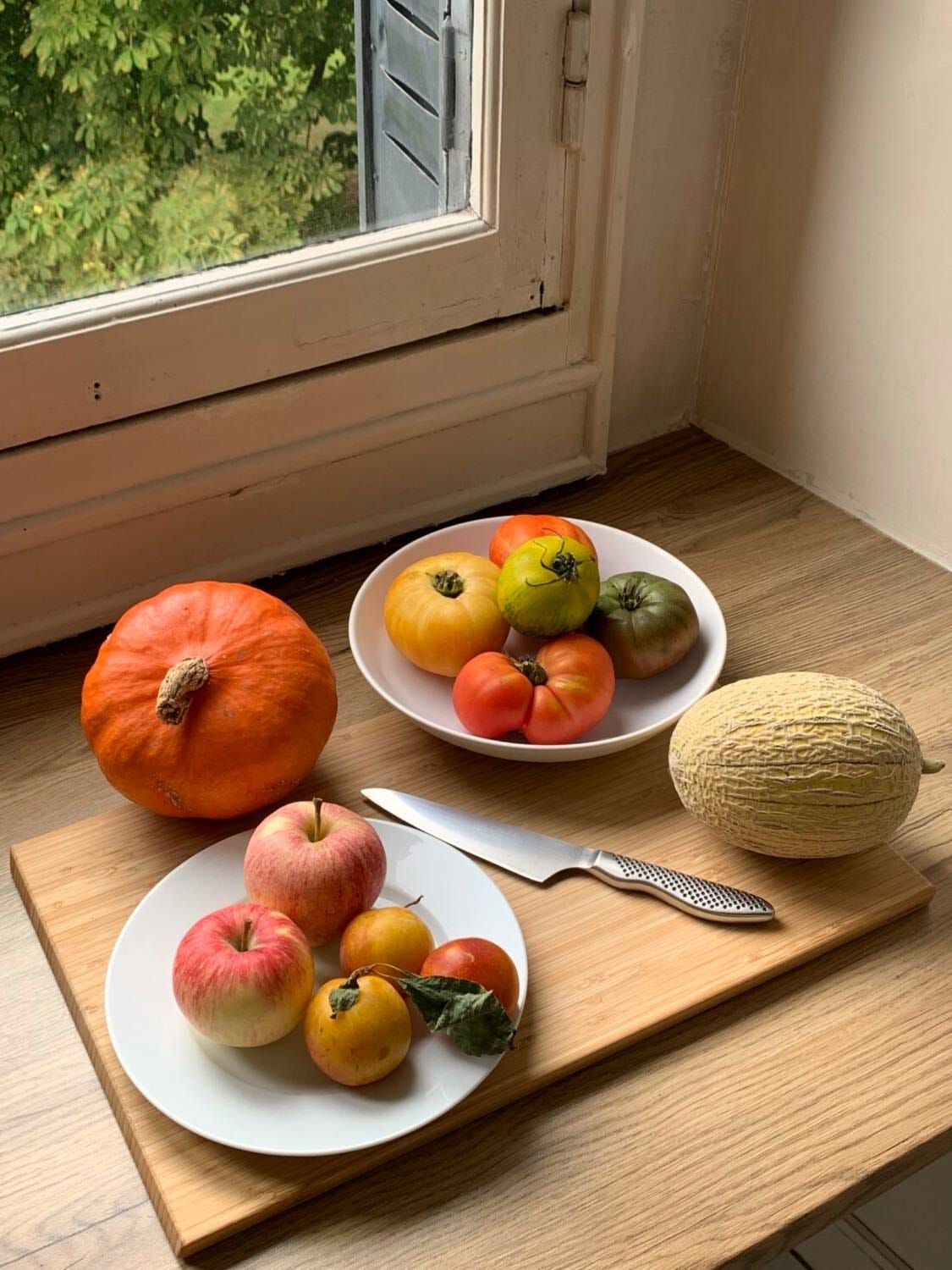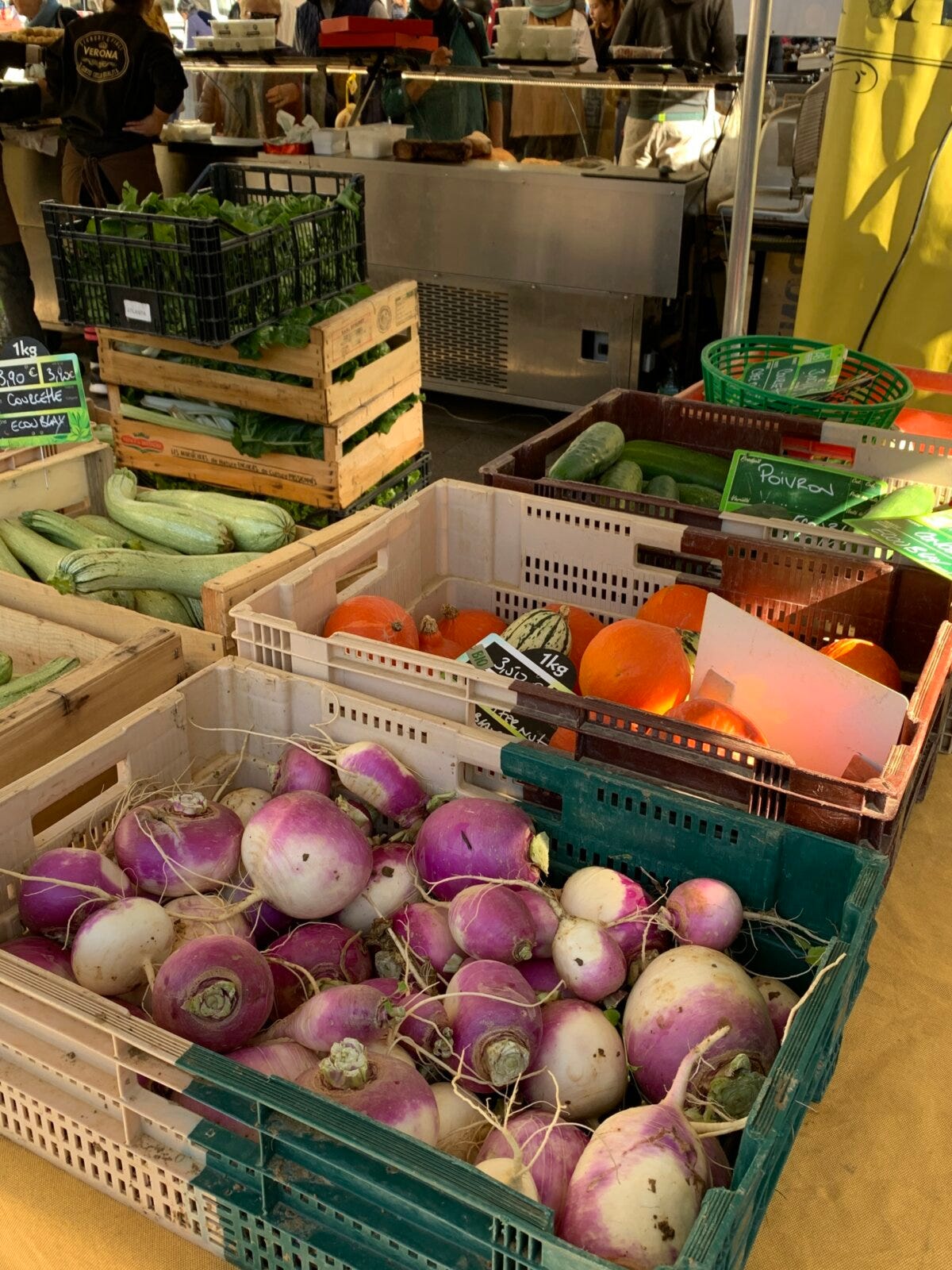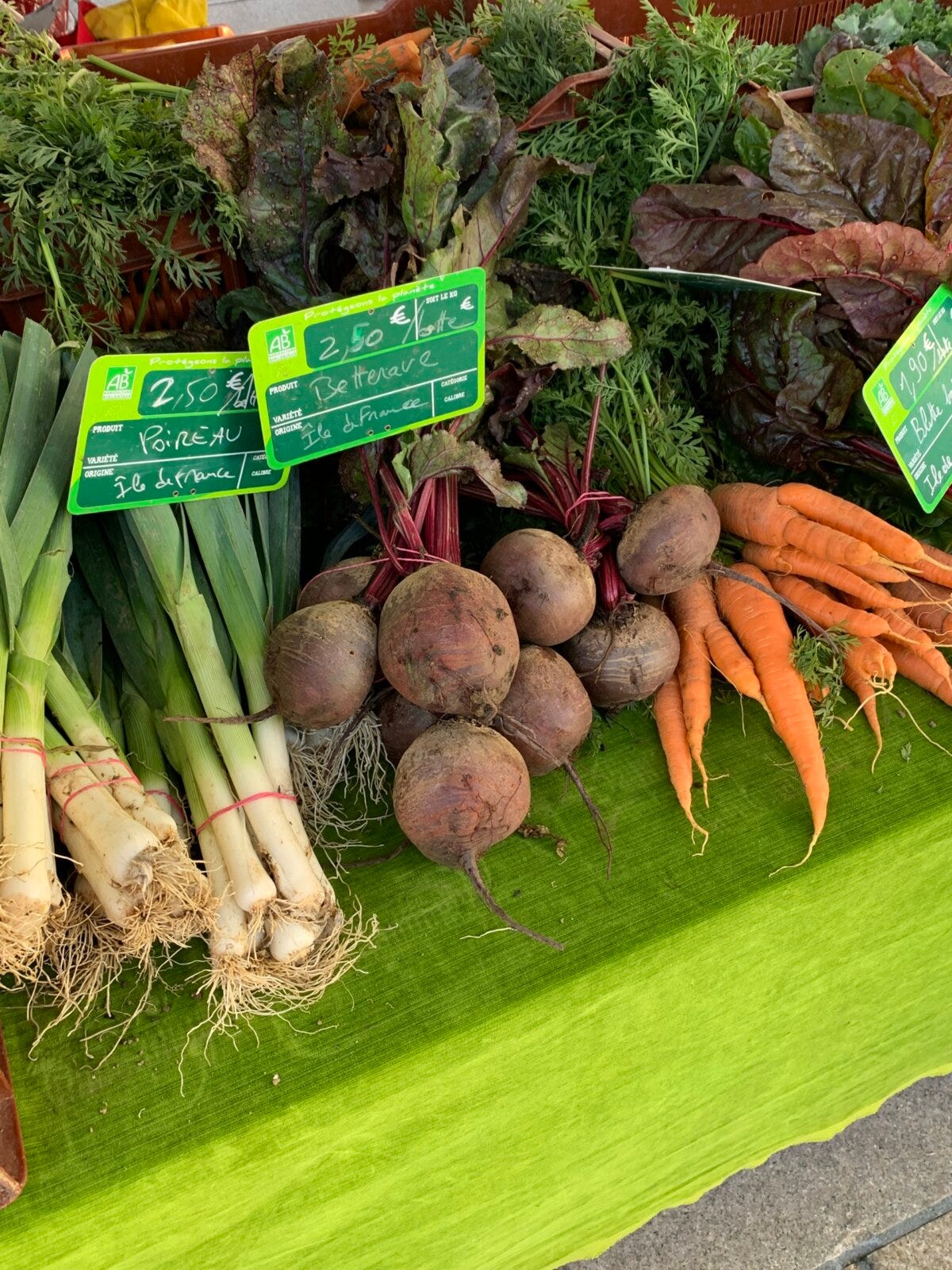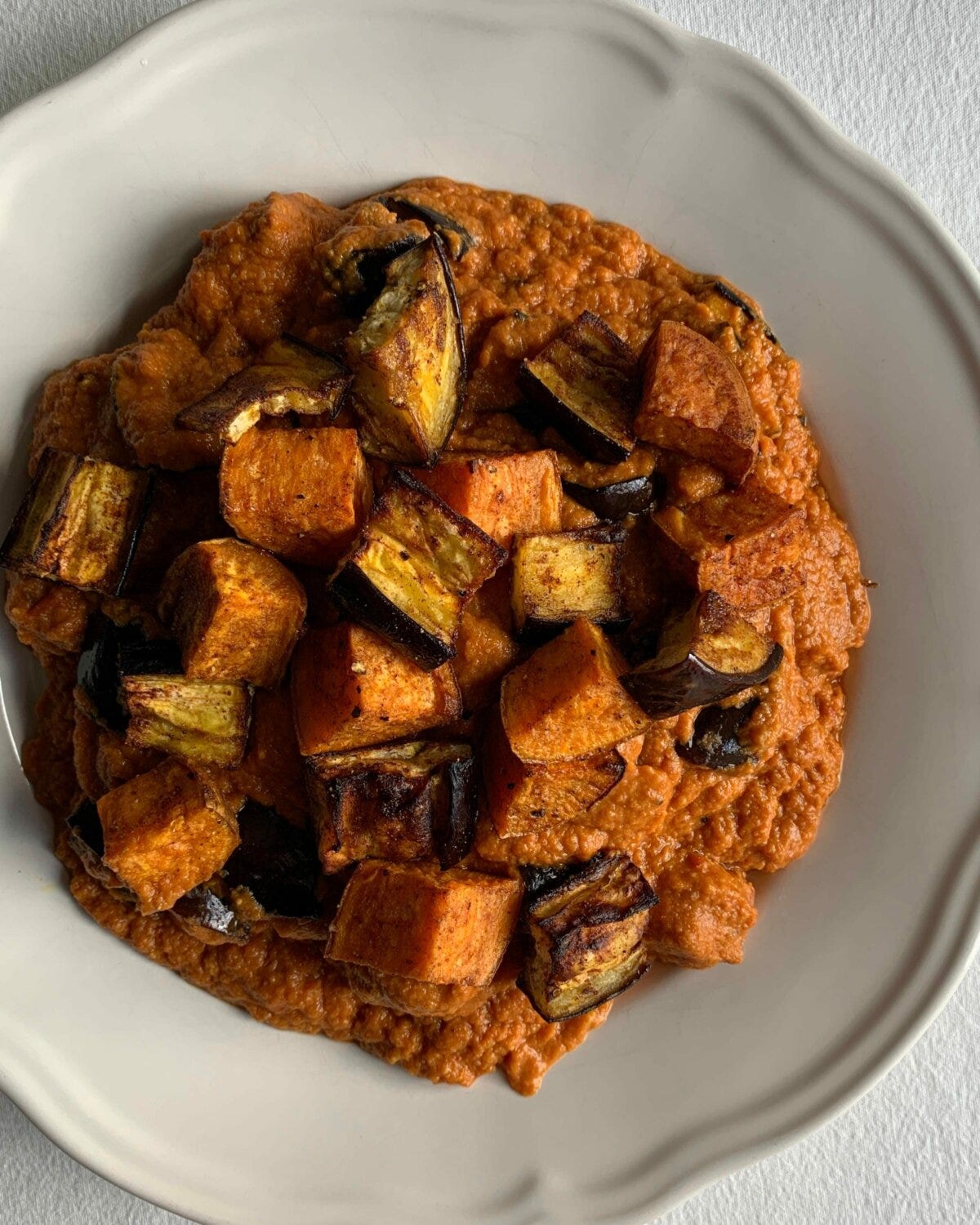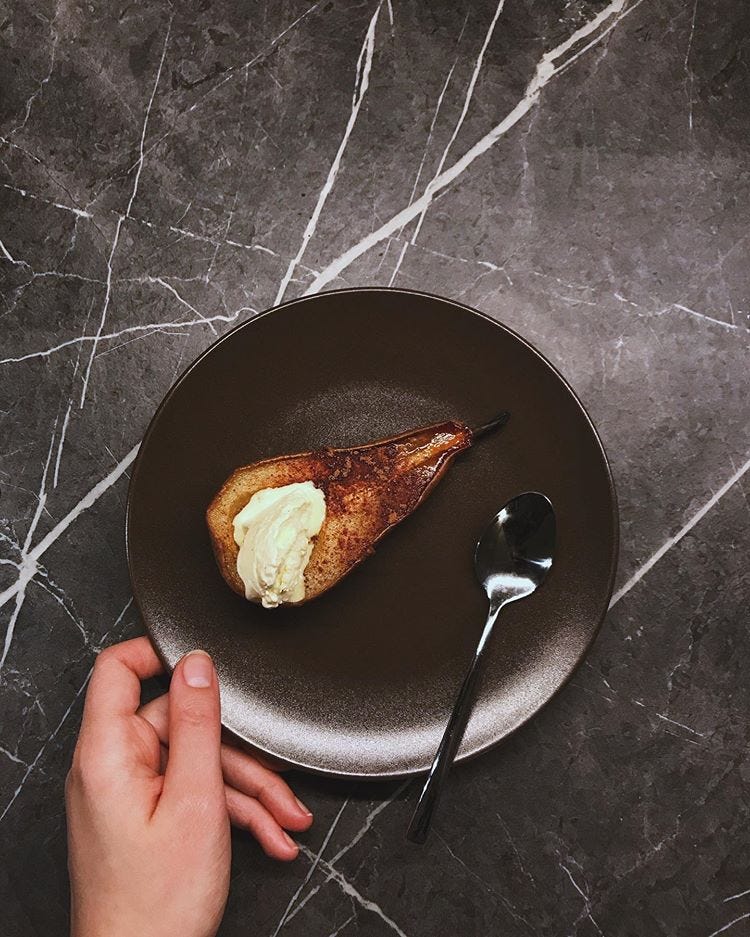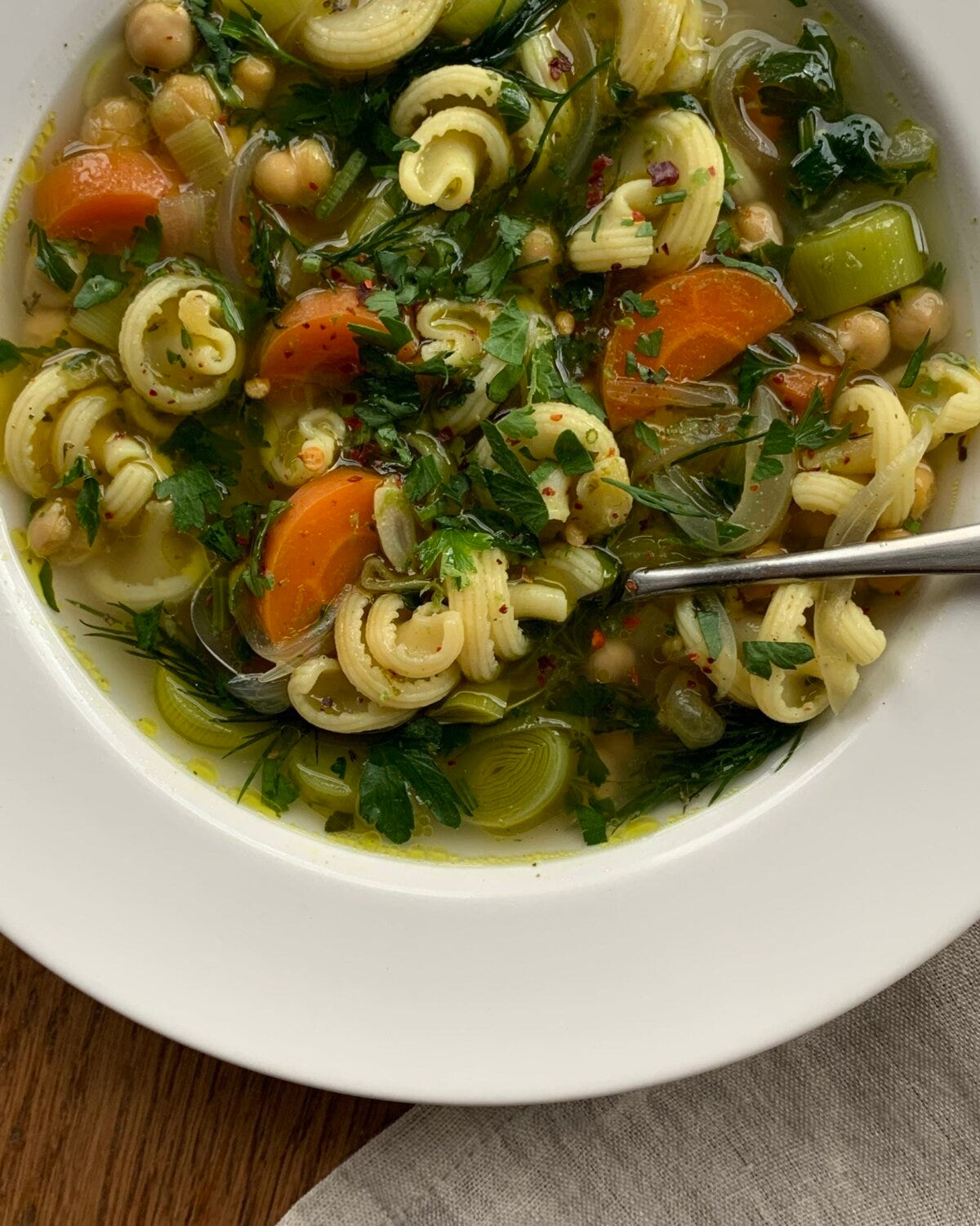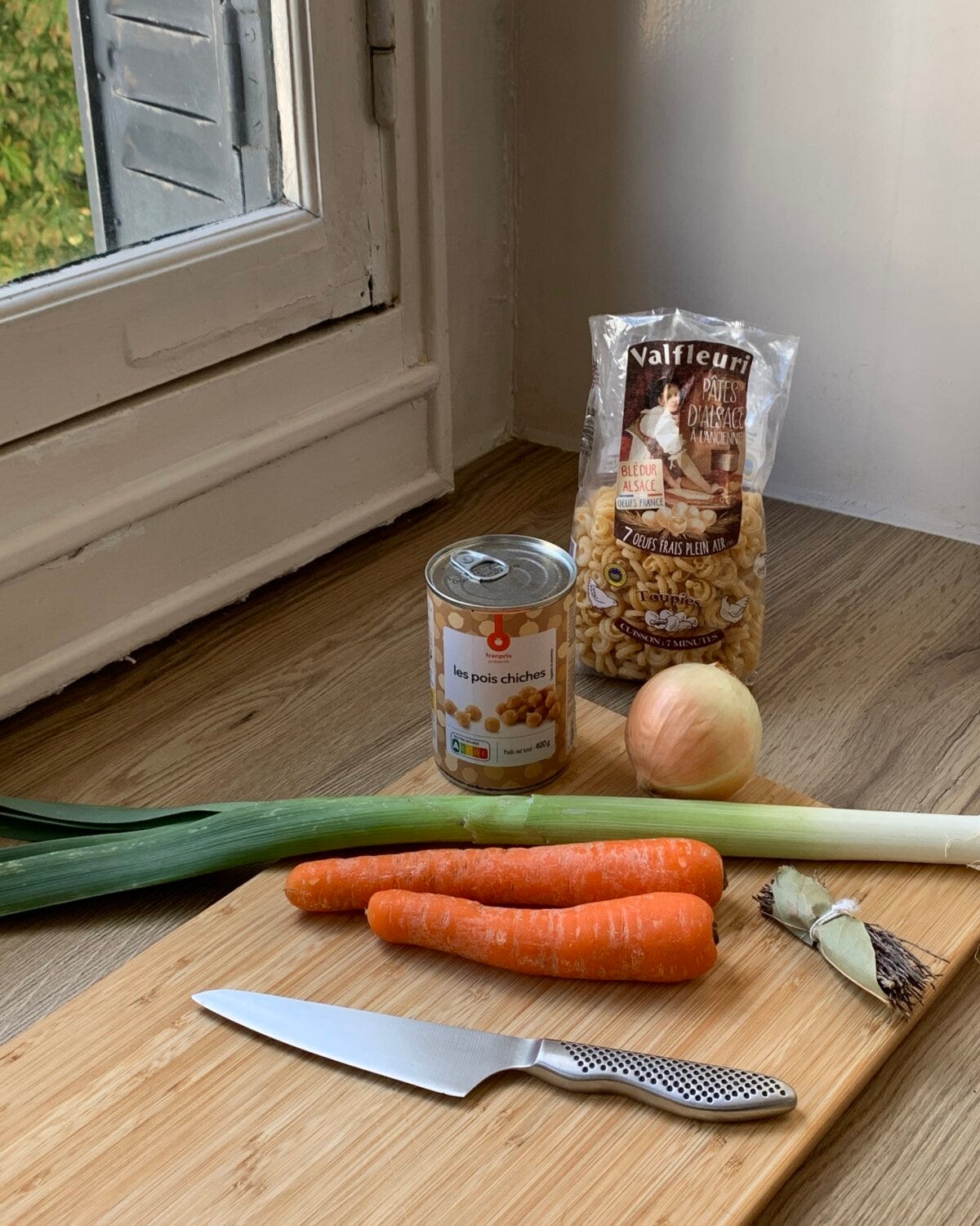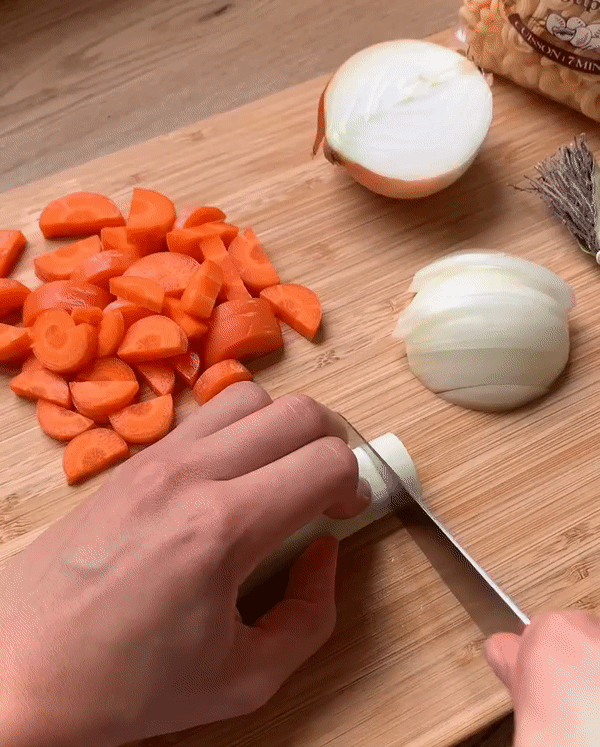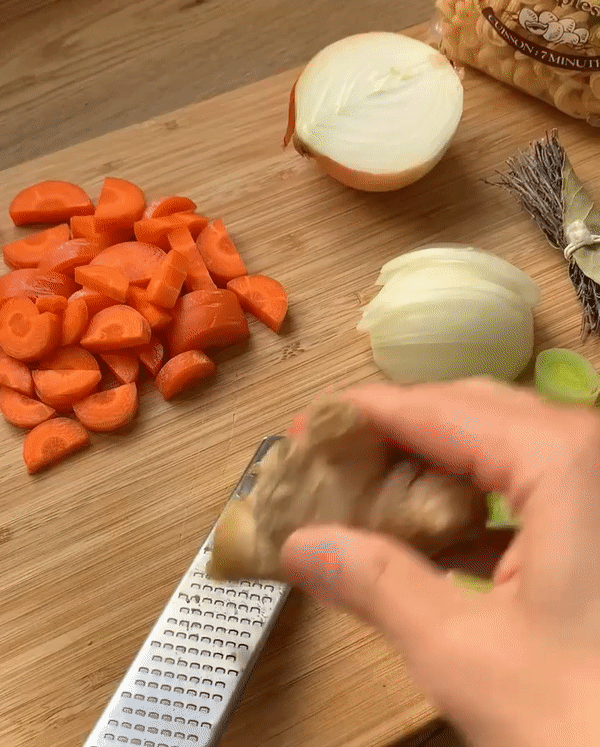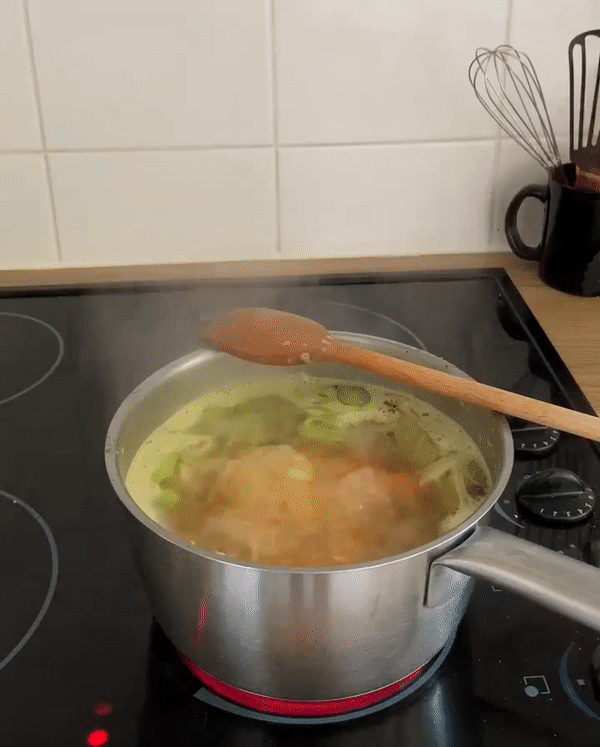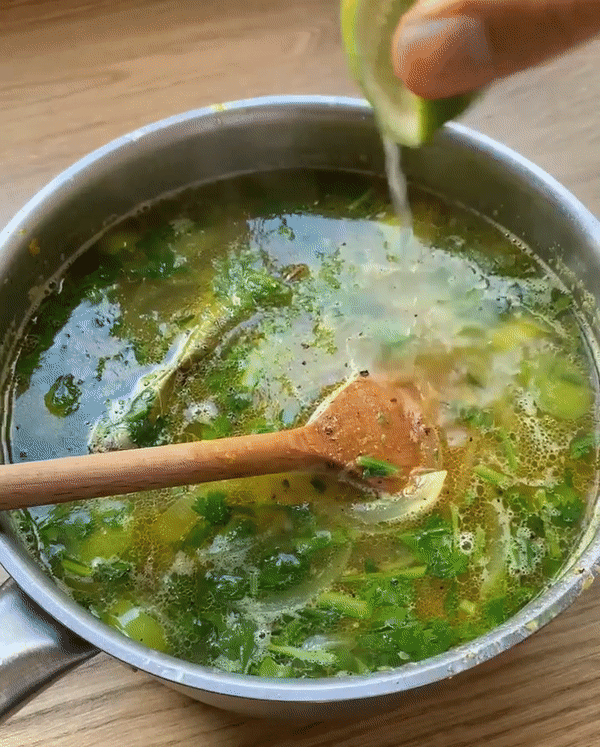Chickpea Noodle Soup
and other seasonal comforts (plus: creating an inviting atmosphere for any occasion)
Allô! 👋
Early fall is here! The days are still warm and the sun still golden, but the evenings are getting cooler, darker, and downright cosier with each and every passing night.
I've still got tomatoes on my kitchen counter, however the likes of zucchini, plums, eggplant, grapes, and corn are slowly being replaced by hardier friends, such as apples, mushrooms, cabbages, parsnips, beetroot, and leeks.
Like clockwork, I've also suddenly been struck with a strong desire to pick up some knitting needles, pop a cake into the oven (or place a steaming pie onto a ledge), and light some candles anywhere and everywhere that doesn't represent a fire hazard around the house.
Speaking of which, you don't need me to tell you that lighting a candle or two is fantastically simple way to create a mellow atmosphere. In fact, it's one of my favourite ways to kindle a cosy mood: turn off any overhead or bright white lighting, turn on and dim any warm-toned lamps, and light a handful of beeswax tea lights, jarred candles, and candlestick or two. Throw in some soft fabrics and linens, add to that a few good tunes, and just like that you've got yourself a real mellow atmosphere.
When it comes to creating a pleasing (and pleasant) dining ambience, it's important to remember that sharing a meal isn't only about sharing food with others — it's also about creating and sharing a moment, and hopefully making good memories in the process.
It doesn't really matter if your plates match, if your chairs would look right at home in a fancy magazine, or if the meal you served was inspired by the latest food trends. What matters most is making people feel comfortable, heard, and included, and making sure everyone's needs are being met: “Do you have enough water in your glass?”, “Would you like a cushion on your seat?”, “I know not everyone around the table can eat gluten or eggs, but no worries — I went to a local bakery and got us a flourless vegan cake for dessert!”. All of these seemingly very little things can go a rather long way.
Other small touches, appropriate in any season but especially welcome once picnic and barbecue season turn to more frequent indoor eating occasions, include popping small seasonal flowers into vases and using them to decorate the table, putting throws on the backs of people's chairs so no one gets cold if still dining al fresco, and offering everyone a cup of something hot and herbal at the end of the meal. You'd be amazed what a boost to the mood these things can be, even as part of one's daily routine. By applying time, care, pride, and attention to the small everyday things we do, we can transform routines into rituals, and turn even the most ordinary of meals into something quite special.
Speaking of moods — the weather definitely affects one's mood, and one's mood most definitely affect one's cravings. In early fall, a light vegetable soup often seems to hit the spot. In late fall, something more substantial is more likely to feel in order — for most, adding hearty beans and legumes, a splash of dairy, or something nice and starchy usually does the trick. I find that this progression is where things get interesting, because one then finds oneself gliding across a spectrum whereby one can encounter anything from saucy soups to soupy stews and stewy sauces.
Imagine a sort of soup matrix, or chart with four quadrants, with the x axis going from smooth to chunky, and the y from clear, thin liquids all the way to more opaque, soft solids. This is fantastic news in terms of rejigging leftovers — it means a thick dip can be thinned into a thin soup, a thin soup can be bulked out into a chunky stew, a chunky stew can be reduced and lightly blitzed into a textured sauce, and so on and so forth. The possibilities and permutations are seemingly as satisfying as they are endless.
Now that we've stewed over things getting saucy, I hope this month's newsletter can offer you a gentle introduction to this transitional time of year (often referred to as soup season, and aptly so). In it you'll find a guide to peak produce of the moment, comforting recipes — old and new — for soup and other cosy dishes, and a brief round-up of media from the last month relating to food and public health. I encourage you to read on with a cup of something warm in hand, some good music in ear, all as you sit comfortably, perhaps curled up under a light blanket, soaking up the warmth of the sun (or the quiet calm of falling raindrops — don't forget the dim, warm light). I think that would be delightful.
Wishing you a cheerful October ahead!
Sending warm hugs (and cool tunes),
👋simone
note: this month's newsletter contains a fair amount of photos and GIFs, some of which may take a while to load — if you're having any difficulties viewing them in your inbox, you can always click the link at the top of this e-mail to open the newsletter in a browser instead 💛
it's early fall:
what to cook?
🍂
Ah, fall cooking. The start of a long season of transforming tough roots, sturdy brassicas, and robust gourds into soft, gentle, and comforting dishes — all thanks to the generous application of warming spices, rich broths, and savoury sauces (something which, admittedly, by the end of February, gets to be a little bit humdrum). Some people refer to this time of year as "the start of brown food season", but I'd argue that it's far from that: vividly orange squashes, bright red and pink and golden beets, deeply green cabbages, snow white parsnips and chicories, delicately pale celery, cauliflower, and chameleonic quince all dare to challenge the notion.
Be that as it may, there's absolutely nothing inherently wrong with brown foods. Let us not discriminate! In fact, here are some ideas for meals of all colours to help you celebrate and make the most of fresh seasonal produce this fall:
mushrooms 🍄 although you can find button mushrooms grown indoors year-round, you'll want to be keeping an eye out for the forest-foraged varieties at this time of year. their unique textures make them great flavour-sponges, as well as the perfect substitute in any dish where you might be otherwise tempted to cook some meat. pair well with: cream, garlic, miso, white wine, thyme, soy sauce, black pepper
swiss chard, beetroot, spinach & other beet relatives now is really the time for these vegetables to shine, when they're still crisp and it's early enough in the year to enjoy their dark leafy greens at their most fresh; roast them, sauté them, savour them raw! no matter how you choose to enjoy them, you're bound to feel delightfully nourished once you've absorbed their colourful goodness. pair well with: balsamic vinegar, goat cheese, rosemary, barley, hazelnuts, nutmeg, currants
apples, pears & quinces 🍎 though raw apples and pears make great fuss-free snacks, cooking them — as well as quinces — opens up a whole new world of flavour. these bake beautifully into crumbles or cakes, are fantastic poached in spiced wine for dessert, and will balance roasted meats and various cheeses with ease and flair. pairs well with: pork, red wine, cinnamon, thyme, brie
celery, onions & leeks each is fantastic alone in its own right, but together they can work magic in the shadows and make other ingredients truly shine. dice finely and soften in a bit of fat as a base for nearly any dish, or braise whole in a rich flavoursome broth, and you're practically guaranteed to have a nice meal. pair well with: garlic, white wine, bay leaves, mustard, chicken broth, white beans
winter squashes & pumpkins 🎃 excellent roasted with nothing but a lick of oil and a sprinkling of salt, you'll want to put these in your soups and salads and rice dishes and pasta dishes too. have extra time on your hands? try roasting the seeds (or not) and shelling them (or don't) for a nourishing snack, or a tasty garnish/topping. pair well with: sage, feta, coconut, curry spices, apple, cinnamon, whole grains
brussels sprouts, bok choy, kohlrabi & other cabbages easily overcooked by many, you'll want to steer clear from boiling them for hours on end (though a slow braise is often welcome). best sautéed, roasted or tossed raw through acid until their inner stem is tender and their exterior leaves are vibrant or crisp. pair well with: bacon, balsamic vinegar, orange, garlic, mashed potatoes, cranberries/lingonberries
cauliflower, broccoli & other flowering brassicas 🥦 much like their fellow brassicas above, you don't want to overcook the flavour and texture out of these wonderful veg. consider sautéing on high heat, gratinating into a cheesy, creamy dish, or adding raw to salads. from rapini to romanesco broccoli, these come in a wide variety of colours, shapes and sizes so try to find and enjoy as many as you can. pair well with: ginger, chilies, cheddar, sesame oil, tahini, almonds, lemon
chicories & other bitter leafy things even though summer's gone, the days of beautiful bountiful salads have yet to leave us. from raddichio to endive, and escarole to frisée, you would be forgiven for wanting to eat these every single day. pair well with: wine vinegar, shallots, olive oil, chives, mustard, dill, walnuts, pears, goat cheese
carrot, parsnip, celeriac, rutabaga & other "roots" 🥕 these starchy fellows all make excellent mashes (and will undoubtedly give a much-needed boost to any plain mashed potatoes). consider slow-roasting for at least an hour or so, basting in butter and their own sweet juices as you go, to achieve something caramelised and tender and worthy of being the star of any meal. pair well with: butter, parsley, apples, coriander, fennel, hake and trout
rosemary, sage, thyme & other hard, woody herbs 🌿 they look great. they taste great. they're great for you. this is just a friendly reminder that having fresh, dried or frozen herbs in and around the kitchen is always a great idea. pair well with: pretty much anything, as long as you're creative
One final note: early fall marks the harvest season! A short window of time to preserve summer's bounty, in more ways than one. So, more so now than at any of time of year, let this season be an opportunity to try your hand at making your own ferments, preserves, and dried stores of all kinds — while the harvest's still fresh.
recipes from the site
+ ideas from instagram
✨
warmly spiced peanut stew
Tomatoes, eggplant, sweet potatoes, and peanuts all feel quite at home in this warmly spiced stew that is perfect for transitioning into autumn's early days.
parsnip & apple soup
A comforting classic for a cosy night in — there's no doubt about it, parsnips and apples are a match made in autumn.
cinnamon baked pears
The promise alone of a kitchen filled with the alluring scent of roasting pears is reason enough to make this stupidly easy dessert.
cauliflower + potato soup
Topped with toasted flaked almonds, fresh herbs, and lightly sautéed greens, this filling soup is easy peasy, simple and cosy.
brothy lentils & roast pumpkin
Absolute comfort in a bowl! This dish also makes perfect leftovers (if there are any) the next day.
a chickpea noodle soup
🍲
It often starts with a sore throat. Then come the sneezing and coughing. Congestion. A runny nose. Cold and flu season is back. Soup helps. This is my go-to.
Ginger, turmeric, and aromatic herbs are not only great ingredients for making a meal tasty, they're also great for helping your body fight off whatever it is that's getting you down (I also love making a ginger, lemon, honey tea when sick that gets its kick from lemon peel, turmeric, hot chilis, apple cider vinegar, cinnamon and black pepper — it's great). This soup's got them all, and more.
It also comes together incredibly quickly, is easy to make in large batches (the egg noodles mean it'll keep well in the fridge), and I'd argue it's even low-effort enough for you to make for yourself if you're the one who's feeling poorly. Soup's on!
•••
A CHICKPEA NOODLE SOUP
makes enough for 4-6 portions, depending on serving sizes
INGREDIENTS
• ½ a medium white or yellow onion or 1 banana shallot
• ½ a large carrot or 1 medium carrot
• ½ a medium stalk celery and/or ½ of 1 small leek
• 1 ∼400g (14oz) can chickpeas preferably the kind with just chickpeas, water & salt
• 2-4 cloves of garlic the quantity will depend on their size + your preferences
• 1 ∼2.5cm (1in.) nub of ginger* fresh or frozen
• ½ tsp powdered turmeric or ∼1 tsp grated fresh turmeric
• 2-4 stalks fresh thyme or 1-2 stalks dried thyme
• 1-2 bay leaves fresh or dried
• 1-3 tsp herbes de Provence
• optional: 1 ∼10cm (∼4in.) stick lemongrass I always try to keep some in the freezer!
• optional: 1 stock cube if omitting, go a little heavier on the herbes de Provence; if including, go light on the dried herbs
• ∼1.25L (∼5 US cups) just-boiled water
• 2-3 big handfuls of short, twirly-shaped egg noodles
• 1 big handful of any combination of fresh tender herbs of your choosing: parsley, chives, dill, green onion, coriander, mint, etc.
• optional: dried crushed red chili flakes
• the zest and juice of ½ lime
• extra virgin olive oil
• sea salt
• freshly cracked black pepper
*note: I personally love to keep ginger, loose, in the freezer — it makes it really quick & easy to microplane it to a fine paste/mince (and it prevents you from getting any fibrous bits in your food!)

METHOD
1. Start by prepping your ingredients: peel the halved onion, and slice it from root to shoot into thin(ish) strips. Halve the carrot lengthwise, then slice it across its length into half-moons. Thinly slice the celery and/or leek into "coins" as thick as the carrot pieces — if using a leek, cut the white parts into half-coins while keeping the green coins whole (make sure you clean the leek well, so you don't end up with any sandy grit in your soup! You may also want to remove its outermost layer(s), if they feel dry and/or tough).
Next, open the can of chickpeas. Drain and rinse under cool running water until no more foam appears, removing any loose skins in the process. Set aside to dry on a clean tea towel while you prepare the garlic and ginger. Peel the garlic cloves, then give them a fine rough chop or a thin slice. For the ginger (and turmeric, if using fresh), you may keep or remove the peel before thinly slicing or microplaning to a fine pulp.
2. Place a medium-sized pot over medium-high heat. Add just enough olive oil to cover the bottom of the pot, then, once the oil is hot, pour in the chickpeas. Season generously with salt and pepper and cook, stirring occasionally, until the chickpeas have turned golden.
Add the garlic and cook a few minutes more, stirring frequently, until the garlic has also turned golden.
Next, remove the chickpeas and garlic from the pan using a slotted spoon, and transfer them to a small bowl. Cover the bowl with a plate (to retain moisture) and set aside.
3. Add the onion, carrot, and celery to the pot that contained the chickpeas, along with an additional glug of olive oil. Season with salt and pepper and cook on medium heat, just until the onion begins to soften and become translucent, then add the ginger and turmeric and cook two minutes more, stirring as you go to stop the turmeric from catching at the bottom of the pot and burning.
Next, add the thyme, bay, herbes de Provence, optional lemongrass, and optional stock cube. Give everything a few more stirs before covering with the just-boiled water. Turn the heat up to high, and bring the water back to a boil.
4. Once the broth has come to a boil, add in the noodles and cook over medium-high heat for 3 minutes less than indicated on the noodle package's instructions. While the pasta cooks, roughly chop the fresh tender herbs by rolling them up into a tight bundle and slicing across with a well-sharpened knife (ideally, your knife was well-sharpened all along!).

Reduce the heat to medium, then add in the reserved chickpeas and garlic. Give the soup a taste, then season accordingly with more salt and pepper. If using chili flakes, you may also add a pinch or two in at this point.
Turn the heat off before adding in most of the chopped herbs, then add in the lime zest and squeeze in its juice.
5. Transfer to bowls, top with more freshly chopped herbs and optional chili flakes, serve hot and enjoy! Let any leftovers cool before transferring to a glass jar or container and storing in the fridge.
The soup will keep well in the fridge for up to 5 days, or in the freezer for up to 3 months (if choosing the latter, take care to not overfill your container, as the liquid will expand as it freezes — and I'm guessing you'd rather not have any mess!).
a note on the noodles: the soup stores well with the noodles in it because egg noodles are quite good at holding their shape, but if you are using eggless noodles, I would recommend not adding them to the soup until ready to eat (simply cook them separately and add them in just before serving) — if it's helpful, I can tell you that you can also do this with diced sautéed potatoes instead of noodles
last, but not least:
the public health corner:
a few parting links, as food for thought 🔗
📺 ONE VIDEO
Remodeling America's School Lunches with Brigaid (Brad Leone / YouTube)
🗒️ ONE ARTICLE
Many of today’s unhealthy foods were brought to you by Big Tobacco (The Washington Post)
🎧 ONE PODCAST EPISODE in english, french, and norwegian
EN The shocking damage ultra-processed foods cause to your brain (ZOE Science & Nutrition)
FR Une leçon de nutrition positive et durable (On va déguster)
NO Hva og når skal vi spise? (Hjernesterk)
📘 ONE BOOK
Diet for a Small Planet, Frances Moore Lappé (Penguin Random House)
P.S. I always have a hard time just picking one of each so, in case you're interested, there's plenty more where that came from!
That's all from me this month!
See you in the next time
💛
This was a Substack edit of an archived newsletter. To read the newsletter in its original format, click here.





